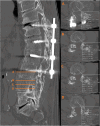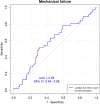The Association Between Hounsfield Units and Mechanical Failure in ASD Patients
- PMID: 39397242
- PMCID: PMC11559791
- DOI: 10.1177/21925682241291519
The Association Between Hounsfield Units and Mechanical Failure in ASD Patients
Abstract
Study designRetrospective Cohort Study.ObjectivesLow bone mineral density (BMD) is a known risk factor for revision surgery in patients with adult spinal deformity (ASD). Hounsfield units (HUs) on CT scans have been suggested as a proxy for assessing BMD. This study aimed to determine HUs in the lumbar region and their association with mechanical failure in patients undergoing ASD surgery.MethodsWe included ASD patients undergoing surgery from 2010-2020 with minimum 2-year follow-up. We excluded patients without preoperative CT scans, or a CT scan more than 1 year before surgery. Mechanical failure was defined as proximal junctional failure, pseudarthrosis, or implant failure requiring revision surgery. On preoperative CT scans, HUs were measured on 3 axial slices on each vertebra from L1-L5 and, if available, at UIV and UIV + 1.ResultsWe included 170 patients, mean age 63 (±12) years, with 108 (64%) females, and 13 [IQR 10-16] instrumented levels. Mechanical failure occurred in 27% (n = 46) of patients at 2-year follow-up. Mean lumbar HUs were 146 (±51) in the mechanical failure group and 135 (±52) in those without revision (P = .232). Area under the curve was 0.58 (95% CI: 0.48-0.68), corresponding to no to low discriminatory power in predicting mechanical failure using lumbar HUs. Univariate logistic regression revealed no significant difference between mechanical failure and lumbar HUs (OR = 1.00, 95% CI: 1.00-1.01, P = .239).ConclusionsWe found no association between mechanical failure and HUs on preoperative CT scans in ASD patients. Thus, we cannot recommend using HUs to predict mechanical failure in these patients.
Keywords: CT; adult spinal deformity; hounsfield units; mechanical failure; revision surgery.
Conflict of interest statement
Declaration of Conflicting InterestsThe author(s) declared the following potential conflicts of interest with respect to the research, authorship, and/or publication of this article: MG: Institutional grants from Cerapedics, institutional grants from NuVasive, institutional grants from Stryker; BD: Stryker (consultancy), supported by The Alfred Benzon Foundation; the remaining authors report no conflicts of interest.
Figures


Similar articles
-
The association between lower Hounsfield units of the upper instrumented vertebra and proximal junctional kyphosis in adult spinal deformity surgery with a minimum 2-year follow-up.Neurosurg Focus. 2020 Aug;49(2):E7. doi: 10.3171/2020.5.FOCUS20192. Neurosurg Focus. 2020. PMID: 32738804
-
The importance of Hounsfield units in adult spinal deformity surgery: finding an optimal threshold to minimize the risk of mechanical complications.J Spine Surg. 2023 Jun 30;9(2):149-158. doi: 10.21037/jss-22-102. Epub 2023 Jun 14. J Spine Surg. 2023. PMID: 37435329 Free PMC article.
-
Correlation of vertebral trabecular attenuation in Hounsfield units and the upper instrumented vertebra with proximal junctional failure after surgical treatment of degenerative lumbar disease.J Neurosurg Spine. 2020 Dec 4;34(3):456-463. doi: 10.3171/2020.7.SPINE20920. Print 2021 Mar 1. J Neurosurg Spine. 2020. PMID: 33276340
-
Which Bone Mineral Density Measure Offers a More Reliable Prediction of Mechanical Complications in Adult Spinal Deformity Surgery: Hounsfield Units or DEXA Scan?World Neurosurg. 2023 Oct;178:e657-e665. doi: 10.1016/j.wneu.2023.07.140. Epub 2023 Aug 4. World Neurosurg. 2023. PMID: 37543204
-
The association between bone mineral density and proximal junctional kyphosis in adult spinal deformity: a systematic review and meta-analysis.J Neurosurg Spine. 2023 Apr 7;39(1):82-91. doi: 10.3171/2023.2.SPINE221101. Print 2023 Jul 1. J Neurosurg Spine. 2023. PMID: 37029673
References
-
- Heegaard M, Johanning Bari T, Dahl B, Valentin Hansen L, Gehrchen M. Demineralized cortical fibers are associated with a low pseudarthrosis rate in patients undergoing surgery for adult spinal deformity without three-column osteotomy. Brain & spine. 2023;3(April):101751. doi:10.1016/j.bas.2023.101751 - DOI - PMC - PubMed
LinkOut - more resources
Full Text Sources

